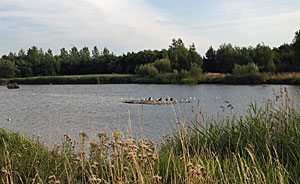Nottingham
Nottingham, the regional capital of Nottinghamshire, received its first charter from Henry II in 1155 and was made a city in 1897. It has long been associated with the legend of Robin Hood, Raleigh bicycles and the home of the Luddites. The city also played a decisive role in the development of industrial Britain, with the advent of Arkwright's spinning machine in 1769, transforming Nottingham into the lace capital of England.
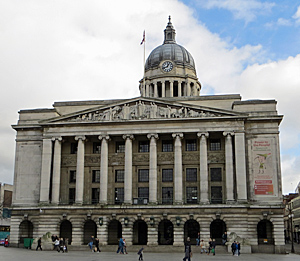
Nottingham Town Hall © TAB
The old medieval town grew up around its castle and market place, which is now at the centre an extensive shopping district, with two large indoor centres, plus a wide range of branded chain stores and many smaller independent outlets. At the heart of the city is the old Market Square, one of the largest market places in the country, and once the setting for its famous October Goose Fair. The fair, which began in medieval times, is one of the largest in the UK. Quickly outgrowing this central venue by the early 1900s, it has been held since in Forest Fields on the northern edge of town.
Today the city boasts three of the oldest sporting societies in Britain. The Trent Bridge county cricket club, opened in 1838. Nottingham Forest FC, established in 1865 and Notts County FC, established in 1862 - the oldest Football League club in England.
Nottingham has many historical attractions, such as the Lace Centre, brimming with delicate white and cream Nottingham Lace, the 17th century Nottingham Castle, and the 750 year old caves under the town centre. Located just below the castle is the 'Trip to Jerusalem'. Once a brew-house for the castle, it claims to be one of the oldest public inns in Britain, dating back to around 1189. It is said that the Crusaders stopped there for a hearty tankard of ale before setting off on their long journey to the Holy Land.
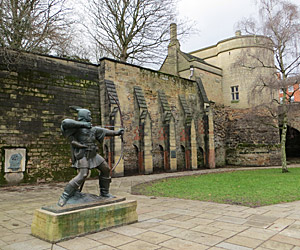
Statue of Robin Hood below the Castle © TAB
To the east of the castle hill stands a bronze statue of Robin Hood, the legendary outlaw of Sherwood Forest. The forest (to the north of Nottingham), once covered some two hundred square miles during the 12th century but now much has been felled for farmland. It was from this forest that the folklore hero is said to have carried on his infamous feud with the Sheriff of Nottingham. However, Nottingham's earliest records of a sheriff are not until 1449. It is possible that the stories may have been based on one of the many 12th or 14th century outlaws, who continued to resist the Norman and Plantagenet kings of that era.
Tourist Information Centre: |
1-4 Smithy Row, Nottingham, NG1 2BY - Tel: 08444 77567 |
Places of interest to visit in Nottingham
Nottingham Castle
A fortress has stood on this rocky outcrop, high above the city centre, for over 900 years. The current 17th century stately home, which replaced the original motte-and-bailey, is now home to the city museum, art gallery and the Sherwood Foresters Regimental museum.
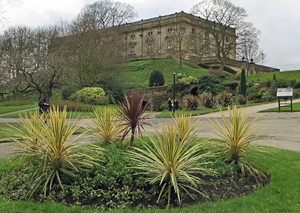
When Charles I fled from London to assemble an army against his rebellious Parliament, he raised his standard at this Castle. However, he was not its first royal visitor, as Edward III lived there for a time, and it was here that Edward IV proclaimed himself king. It was also from this fortress that Richard III set out to his defeat on Bosworth Field in 1485. In 1674 the 1st Duke of Newcastle bought the 'Castle Rock' site and built the stately mansion house and gardens that cover the site today.
The medieval main entrance gateway still stands below it, giving an impression of how the site would have looked in earlier times. It comprises a castle gate house, bridge and lower towers, which were extensively restored during the Victorian era.
Opening times: all year, daily 10am - 5pm. Grounds 8-dusk. Admission Charge
Location: Castle Road, Nottingham City Centre,
NG1 6EL - Website
The Lace Centre
Tells the story of Nottingham's famous lace industry. The centre is brimming with examples of intricate lace designs and laced cloth. Weekly demonstrations of lace-making take place on Thursday afternoons from March to October.
During the Industrial Revolution, Richard Arkwright set up his first spinning mill in Nottingham in 1769, James Hargreaves introduced a spinning jenny in 1770 and John Heathcoat added a lace-making machine in 1809. However, a thriving cottage industry of hosiery and knitwear had already existed since the l7th century, using the simple stocking frame invented by William Lee. But it could not compete with these new sophisticated inventions and the cottagers were barely able to make a living. In 1811 they joined together and sabotaged many of the new machines that had usurped their living. The gangs became known as Luddites, after their leader Ned Ludd. Despite these drawbacks, Nottingham's knitting and lace industries expanded up until the late 19th century, when Nottingham lace became renowned worldwide.
Opening times: all year exc. Xmas, daily 10am - 4pm (times may vary in summer), Admission Free
Location: Severns Building, Castle Road, Nottingham, NG1 6AA
Nottingham Caves
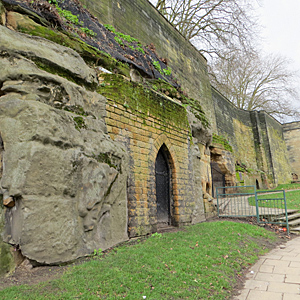 The city of Nottingham is built on soft sandstone, an easy rock in which to carve tunnels to provide shelter or hiding places. There are many such tunnels under the city, some of which were even used as air raid shelters during WWII. Several of the tunnels are open to the public and guided tours are provided for tunnels under the castle hill and the Broadmarsh Shopping Centre.
The city of Nottingham is built on soft sandstone, an easy rock in which to carve tunnels to provide shelter or hiding places. There are many such tunnels under the city, some of which were even used as air raid shelters during WWII. Several of the tunnels are open to the public and guided tours are provided for tunnels under the castle hill and the Broadmarsh Shopping Centre.
Opening times: vary call 01159
520555 for details
Admission Charge
Location: Drury Walk, Inside Broad Marsh Shopping Centre (Upper Level), NG1 7LS
Galleries of Justice
located on the site of the city's old Court and County Gaol. Provides a gruesome, yet informative, insight into what prison life was like for prisoners and wardens over the previous three centuries.
Opening times: all year, Tue-Sun (Mon during SH) & BH Mon 10am - 5pm, Admission Charge
Location: The Shire Hall, High Pavement, Lace
Market, NG1 1HN
Green's Windmill
Restored working windmill. Regular demonstrations show how wheat grain is milled into flour.
Opening times: all year Wed-Sun, 10am - 4pm, also BHs, Admission Free
Location: Windmill Lane, Sneinton, NG2 4QB
Museum of Nottingham Life
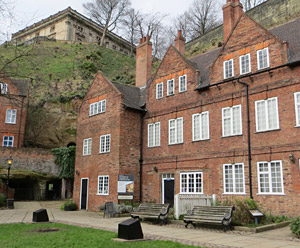 Located just below the Castle Hill, and housed in a row of 17th century cottages, the museum provides a realistic glimpse of life in Nottingham over the previous 300 years. Exhibits include many period rooms and a 1920s shop front, plus caves dug into the hillside.
Located just below the Castle Hill, and housed in a row of 17th century cottages, the museum provides a realistic glimpse of life in Nottingham over the previous 300 years. Exhibits include many period rooms and a 1920s shop front, plus caves dug into the hillside.
Opening times: daily (exc. Xmas) 10am - 4.30pm,
Admission Charge
Location: Brewhouse Yard, Castle Boulevard,
Nottingham NG7 1FB - Website
Wollaton Hall and Park
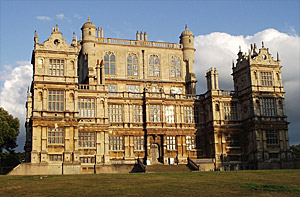 A late 16th and 19th century mansion house set in set in 500 acres of landscaped deer park, filled with herds
of wild red and fallow deer. The grounds contain formal gardens, a lake, nature trails, adventure playgrounds and a sensory garden. The hall and outbuildings host Nottingham's Natural History Museum, Industrial Museum and the Wollaton Park Visitor Centre. The Yard Gallery has changing exhibitions exploring art and the environment. The Hall and grounds also host many events throughout the year include pop concerts, and twilight bat walks.
A late 16th and 19th century mansion house set in set in 500 acres of landscaped deer park, filled with herds
of wild red and fallow deer. The grounds contain formal gardens, a lake, nature trails, adventure playgrounds and a sensory garden. The hall and outbuildings host Nottingham's Natural History Museum, Industrial Museum and the Wollaton Park Visitor Centre. The Yard Gallery has changing exhibitions exploring art and the environment. The Hall and grounds also host many events throughout the year include pop concerts, and twilight bat walks.
Opening times: daily (exc. Xmas) 11am - 4pm, Admission
Free
Location: Wollaton, West Nottingham NG8 2AE -
Website
Image Credit: Bethany Ward
Map of Nottingham
The Midlands


